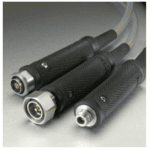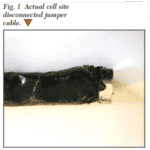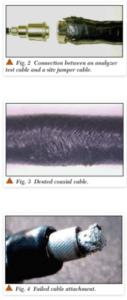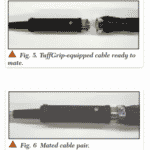Microwave Journal
Originally published in Microwave Journal
A NOVEL SUPER-ROBUST HANDGRIP FOR COAXIAL CONNECTOR ASSEMBLIES
 Times Microwave Systems has introduced a new and unique addition to its popular SilverLine® RF test cables. SilverLine®-TG (TuffGrip®) is specifically designed to address the needs of cellular infrastructure, wireless Internet, and public mobile radio site installers and test technicians.
Times Microwave Systems has introduced a new and unique addition to its popular SilverLine® RF test cables. SilverLine®-TG (TuffGrip®) is specifically designed to address the needs of cellular infrastructure, wireless Internet, and public mobile radio site installers and test technicians.
Extreme temperatures, foul weather, poor lighting, difficult to reach areas and severe time constraints are some of the obstacles with which site technicians must contend. Removal of weatherproofing materials in hot or cold weather can present other obstacles. Schemes to keep moisture from penetrating coaxial connections, such as butyl tape, shrink sleeves and electrical tape, become glue-like with age, requiring knives and cutting pliers to slice through and peel away multiple layers. Disconnecting coaxial cables to perform RF tests at a cell site can require a measure of physical strength and dexterity. Once extricated, the connector coupling nuts and threads often remain smeared with the tar-like weatherproofing materials, making them difficult to reconnect.
 Figure 1 shows the end of an actual cell site jumper cable after having been disconnected for testing. The coupling nut on this cable no longer rotates freely, but requires a significant amount of applied torque. At low temperature, rotating the coupling nut would most likely be only possible with an open-ended wrench. Whether troubleshooting, repairing, or testing a repaired system, the goal is always the same: minimize the down time. In some cases, site technicians report the need of mating and demating cables at a rate of almost one per minute. Properly calibrated torque wrenches are not always available. Over-tightening can result in a ripped cable outer conductor either on the system side or the test side. Other problems include stripped threads or broken system components. The failure can be immediate or latent.
Figure 1 shows the end of an actual cell site jumper cable after having been disconnected for testing. The coupling nut on this cable no longer rotates freely, but requires a significant amount of applied torque. At low temperature, rotating the coupling nut would most likely be only possible with an open-ended wrench. Whether troubleshooting, repairing, or testing a repaired system, the goal is always the same: minimize the down time. In some cases, site technicians report the need of mating and demating cables at a rate of almost one per minute. Properly calibrated torque wrenches are not always available. Over-tightening can result in a ripped cable outer conductor either on the system side or the test side. Other problems include stripped threads or broken system components. The failure can be immediate or latent.
 Due to their constant and repeated use, the RF test cables are often the first to fail. Figure 2 shows the relative size of a typical site analyzer test cable with a 7-16 DIN female and a site jumper cable. While difficult to photograph, a close examination of the coupling nut shows the teeth marks from the use of a pipe wrench. The outside diameter of this analyzer cable is approximately 0.300″, while the site cable is well over 1.5″ in diameter with the weatherproofing. Test equipment manufacturers prefer small diameter cables because they coil more tightly and fit easily into the analyzer carrying case. While they are fine products for a laboratory, when used on-site, their small size makes them more difficult to handle and more easily damaged. Dented coaxial cables (see Figure 3) and failed attachments (see Figure 4) generate cables that exhibit unacceptable return losses or are unstable when flexed. Both are common test cable failure modes. In summary, harsh operating environments, glue-like weather-proofing, the use of improper tools and the hurried nature of the work add up to a need for a significant up-grade in RF test cable ruggedness.
Due to their constant and repeated use, the RF test cables are often the first to fail. Figure 2 shows the relative size of a typical site analyzer test cable with a 7-16 DIN female and a site jumper cable. While difficult to photograph, a close examination of the coupling nut shows the teeth marks from the use of a pipe wrench. The outside diameter of this analyzer cable is approximately 0.300″, while the site cable is well over 1.5″ in diameter with the weatherproofing. Test equipment manufacturers prefer small diameter cables because they coil more tightly and fit easily into the analyzer carrying case. While they are fine products for a laboratory, when used on-site, their small size makes them more difficult to handle and more easily damaged. Dented coaxial cables (see Figure 3) and failed attachments (see Figure 4) generate cables that exhibit unacceptable return losses or are unstable when flexed. Both are common test cable failure modes. In summary, harsh operating environments, glue-like weather-proofing, the use of improper tools and the hurried nature of the work add up to a need for a significant up-grade in RF test cable ruggedness.
SilverLine®-TG (TuffGrip) addresses all these problems with the unique application of a novel, super-robust handgrip (patent pending) around the connector at the system interface end of the cable assembly. The grip allows the user to easily hand-apply as much resistance to a torque or pipe wrench as is necessary to mate to connectors that remain mired in weatherproofing materials.
The RF electrical connection is achieved via a field proven, solder clamp approach. The clamping area transitions to a machined, solid metal sheath. The sheath envelops the RF cable. The sheath and cable are encased inside a rugged armor and an oversized crimp ferrule is added that increases connector retention to a pull force in excess of 200 lbs. This entire system is inside the grip. The inside of the grip is asymmetrical and matches an asymmetrical connector body to eliminate any possibility of connector rotation or twist. The strain relief behind the grip is similarly heavy duty and uses a material and tapered design that matches the flexibility of the armor. This strain relief results in a perfectly smooth transition to a highly flexible, high performance RF cable. The flexibility of the armor also matches the cable so it does not inhibit the minimum-bending radius.
The application of the handgrip and armor addresses the need to make and break RF connections both quickly and reliably under harsh conditions, while eliminating the most common failures that plague site technicians: test cable damage and failure of the connector-to-cable attachment area. The ability to securely manipulate TuffGrip also minimizes the risk of mistakes that damage system jumpers and difficult-to-replace system components.
 Figure 5 shows a TuffGrip® equipped cable ready to be mated to the site jumper. Figure 6 shows the mated pair. The functional diameters of both the test cable and jumper cable are similar, so the applied torque is similar. A cable so equipped makes it possible to easily manipulate both cables with gloved hands. TuffGrip equipped connectors are available in 6 GHz, 7-16 DIN male or female connectors and 6 and 18 GHz Type N female connectors. The 7-16 DIN’s have metrology grade interfaces for smooth, easy action. All connectors are high grade stainless steel for long life and all are capped for protection and cleanliness.
Figure 5 shows a TuffGrip® equipped cable ready to be mated to the site jumper. Figure 6 shows the mated pair. The functional diameters of both the test cable and jumper cable are similar, so the applied torque is similar. A cable so equipped makes it possible to easily manipulate both cables with gloved hands. TuffGrip equipped connectors are available in 6 GHz, 7-16 DIN male or female connectors and 6 and 18 GHz Type N female connectors. The 7-16 DIN’s have metrology grade interfaces for smooth, easy action. All connectors are high grade stainless steel for long life and all are capped for protection and cleanliness.
Popular part numbers for site installers include:
- SLA06-NM7MG-01.50M (6 GHz,
armored, N male to 7-16 male with
TuffGrip, 1.5 m long) - SLA06-NM7FG-01.50M (6 GHz,
armored, N male to 7-16 female with
TuffGrip, 1.5 m long) - SLA06-NMNFG-01.50M (6 GHz,
armored, N male to N female with
TuffGrip, 1.5 m long)
3 m and 5 m lengths in each configuration are available as is an 18 GHz version of N to NF. SilverLine™ test cables are rugged, high performance, highly flexible, phase stable test cables for use in a wide variety of both commercial and military OEM applications. They are available both armored and unarmored in the 6,18 and 26.5 GHz frequency ranges. All connectors are stainless steel, captive contact construction. Connector selections include:
- SMA male, female and right angle
- Type N male and female
- 7 mm
- 3.5 mm male, female and ruggedized
- 3.5 mm female (NMD-style)
- ETNC male and female (extended,
18 GHz range) - 7-16 DIN male and female
- QMA male
All SilverLine test cables including SilverLine®-TG come with Times’s replacement guarantee.
Subscribe to our newsletter!
Interested in receiving email newsletters and other updates from Times? Subscribe now!
